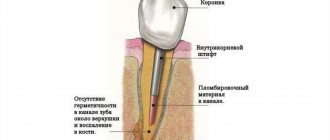Date of publication: 09.24.2018
A dental cyst is a sac in the bone tissue filled with pus. At the early stage of its appearance, a person experiences only pain when pressed. Lack of treatment aggravates the situation and after some time the symptoms change:
- - Constant pain appears;
- - Swelling around the tooth;
- — Increased temperature;
- — Flux;
- - Active formation of pus.
In this case, you urgently need to consult a doctor.
What is a dental cyst?
The inflammatory process - a dental cyst (from the Greek “kystis” - bubble) - is formed in the form of a small inflammatory ball that swells as part of a response to injury or infection. The inflamed area looks like a pus-filled bubble, sometimes reaching several centimeters in size. The body’s active work to restore order and remove slagged cells occurs constantly. At some point, a lot of them accumulate, and our excretory system selects the weakest area of the body through which they can be removed. In this case, the soft tissue around the tooth becomes the target, where a purulent neoplasm appears. An emerging problem can be diagnosed in the early stages using an orthopantomogram.
Treatment of cysts near a tooth is divided into therapeutic and surgical.
Let's consider a therapeutic method for treating cysts:
- High-quality root canal cleaning .
This option is especially effective for treating granulomas (called small dental cysts). The method includes two stages:
- Thorough cleaning of the tooth canals, putting medicine into the tooth canals to sterilize it. The drug used must have an antiseptic, anti-inflammatory and antimicrobial effect. This type of medicine is left in the tooth for up to 14 days under a temporary filling.
- After sterilization of the root canal, drugs are introduced into the tooth, or rather its root canals, that will stimulate tissue replenishment in the area where the cyst was. Control of bone recovery is monitored using radiographs. Such preparations are kept in the tooth from 14 days to several months. After achieving the desired result - disappearance/reduction of the cyst and restoration of bone tissue, the root canals are filled with permanent material and a filling is installed in the tooth.
Why does a dental cyst appear?
What is the prerequisite for the appearance of such an unpleasant disease - dental cyst:
- physical trauma;
- periodontitis, peritonitis, pulpitis - inflammation of the soft tissues around the tooth;
- residual effects after diseases of the nasopharynx - ARVI, complications after influenza;
- decreased immunity;
- advanced caries process;
- poor oral hygiene;
- development of infection in the root canal;
- poorly placed crown, poor quality filling;
- the appearance of problems with the wisdom tooth.
Symptoms of a dental cyst
It is practically impossible to recognize the disease at the stage of its inception. The epicenter of development is located deep in the tissues, so it is quite difficult to immediately make a diagnosis. The inflammatory process makes itself felt when external signs or pain symptoms appear:
- darkening of the enamel, redness of the gums;
- pain when biting, pressing;
- itching sensation near the gums;
- discomfort when chewing;
- the appearance of a tugging, sharp piercing pain in the area of the tumor.
During this period of time it is difficult to determine what is happening where. It seems to the patient that this or that tooth hurts - he may mistakenly indicate a healthy one, but in fact, “dead” cells accumulate, and the inflammatory process enters the next stage of development. A purulent formation is formed: the skin is stretched under the pressure of an enlarged, rapidly growing bladder. As the amount of pus increases, the blister grows in size, exceeding 1 cm in diameter. At this stage, the patient’s sensations and appearance make it possible to visually diagnose a dental cyst:
- swelling of the gums, face;
- severe aching pain;
- elevated temperature;
- lack of appetite, malaise;
- statement of the fact of pain in the lymph nodes, their enlargement;
- headache if a cyst appears in the maxillary sinus.
The problem cannot be ignored. The formation of a purulent capsule does not go unnoticed. The process must be kept under control to avoid side effects. We recommend that you consult a specialist when the first, even the slightest, signs of the disease appear. Timely medical care from a dentist helps save the tooth; its results have a positive effect and cause a cosmetic effect.
General information
Without exception, all home and folk methods for treating cysts are aimed at getting rid of the cause of this disease.
. Therefore, we are not talking about tooth extraction or loss here. Almost always it is either rinsing with various solutions or decoctions, or various lotions.
The most popular remedies for treating dental cysts are lemon juice, sesame oil, some essential oils, myrrh, chamomile, sage, soda, salt.
and others. Tinctures and solutions are prepared according to different principles, and, in addition, the time is not the same in each case.
To create rinse solutions, the concentration of active ingredients is very important, so you need to strictly follow the recipe.
Another reason to turn to folk remedies is their reasonable cost. After all, a fairly large proportion of people who do not seek specialized dental care simply consider these services and activities to be unreasonably expensive. And in many cases this is true.
We will tell you what the symptoms of a dental cyst are in general in a separate review.
This article talks about the most effective ways to treat flux at home.
Here: https://www.vash-dentist.ru/lechenie/zubyi/naznachaemyie-pri-boli-antibiotiki.html - the names of antibiotics taken for toothache are listed.
One more feature of self-treatment at home should be discussed. It almost always stretches out over a fairly long period of time.
. This is due to the lack of direct access to the site of the disease. Here, the effect of drugs is carried out through the penetration of small doses of active substances through the tissues.
Therefore, if the patient expects the fastest possible result (within a few days), he should contact a specialist at the dental clinic. Moreover, the procedure for getting rid of a cyst is quite simple - watch the following video:
What is the difference between a cyst and a granuloma?
There are other diseases in the oral cavity that are symptomatically similar to a cyst. Specifically, a granuloma is an outwardly swollen round projection in the root zone of a tooth. The doctor must correctly diagnose the disease, since the sequence of exposure, removal techniques, and pharmacology have significant differences. Granuloma is eliminated with the help of medications, as well as accompanying mouth rinsing with phytocomponents. The cyst has deeper roots and does not go away without surgery.
Your feedback
simpladent.com I would like to express my gratitude to the entire team for your attention, warm welcome, your patience and professionalism.
And most of all to my doctor Dmitry Alekseevich Sidorov. It was no coincidence that I chose this doctor. Many positive reviews on the Internet prompted me to turn to this doctor. And I can say with confidence that I was not mistaken. This doctor is distinguished by his humanity, ability to communicate with clients, find an approach to them and, of course, high professionalism. Thank you very much again, Dmitry Alekseevich!!! Success in your work, achieving the best results for the benefit of people, bringing joy and health. I wish you success. Good health to you. Charming smiles. Keep it up!" Olga Manaenkova |
10/16/2019 Leave a review Other reviews
The main differences between granuloma and cyst
Indicators and signs for comparative analysis Granuloma Cyst External signs, structure Solid formation covered with connective tissue. Reddish color Cavity with liquid or pus, covered with stretched skin, transparent, dirty-white in color Overall dimensions, diameter of the abscess 40 – 80 mm 90 –300 mm Result of X-ray studies There are no contours of the tumor The image shows a clear border of the round capsule Clinical course of the disease Tooth stable and stands motionless in its place The tooth becomes mobile The condition of the gums and other periodontal soft tissues, lymph nodes Swelling appears in the oral cavity, and redness of the mucous membrane occurs. The effect on bone tissue is insignificant. The cyst develops locally, the inflammation is not transmitted to the mucous membrane. The tumor causes a negative effect by reducing the development of bone tissue, “corroding” it, so the picture shows the process when hard bone tissue decreases
Types of dental cysts
A molar cyst is distinguished by several characteristics:
- depending on the reasons for the appearance;
- according to location.
Distributing according to the reasons that provoke the appearance of a dental cyst, the following varieties are distinguished:
- A keratocyst appears on the lower jaw. Older people are susceptible to the disease. It can turn into a malignant form - it grows deeply into the body and destroys the bone.
- Odontogenic or radicular dental cyst is the most common type. After periapical inflammation and necrosis of the pulp, a granuloma of the dental root is formed in the upper part. The size of the purulent focus ranges from 3 mm to 3 cm. The process does not affect bone tissue and does not provoke tooth displacement.
- A cyst that forms at the site of teething is a retention cyst. It appears during the period of replacement of milk teeth with molars. A purulent fistula with bloody contents looks like a dark blue abscess. Education is formed if the process of eruption is slow. The purulent contents of the abscess should be opened and cleaned out.
- A calcifying odontogenic tumor occurs in the area of the support of the lower jaw. Experts do not have a consensus on the reasons for its formation - they have not yet been fully studied.
- A residual formation with pus occurs after tooth extraction as a result of careless work by the doctor. If a piece of root or a fragment of a tooth remains in the wound, a granuloma forms.
- A follicular cyst forms in place of soft tissues that resist the eruption of a new tooth. A cyst grows around a tooth hidden by the gum, enlarges and can spread to other teeth. The result of the development of a cyst can be tilting, tooth displacement or root resorption.
- A lateral periodontal cyst looks like a small formation, most often found on the lateral part of the root.
Depending on the location of the purulent tumor, there are:
- A cyst is formed on a tooth root. Three location options: basal, inter-root or peri-root zones. When a purulent capsule forms, the disease manifests itself well.
- The purulent focus is located in the maxillary sinus. Making a diagnosis is extremely complicated - you cannot do without an image of a certain area. In the advanced phase, the cyst provokes the appearance of sinusitis.
- At the initial stage, a cyst on the gum is asymptomatic. At the moment of filling with purulent contents, the bubble begins to grow rapidly. In treatment, medications are used, and they are also fought by puncturing the capsule, treating with saline solution and cleaning until complete healing.
- The formation of a cyst under the tooth crown occurs after unsuccessful disinfection during its installation after treatment. As a result of a loose fit, food debris gets under the crown, rots and creates a favorable environment for cyst growth. To treat it, you need to remove the crown.
- A cyst on the front teeth has practically no room for development and localization. It comes out at the initial stage of development.
- A wisdom tooth cyst forms at the site of a long-erupting “figure eight.” As a treatment for this category of teeth, a proven effective method is recommended - removal of the cyst and wisdom tooth together.
What to do with a dental cyst?
Features of the development of purulent inflammation of various forms and localizations show that the formation occurs at a slow pace. When pronounced symptoms appear, the cyst emerges on the surface of the mouth, gum or root, inflamed and filled with pus. Patients complain of severe malaise, “fever,” experience pain and discomfort when chewing food.
A decade ago, the only solution to getting rid of the problem was the ability to remove the source of pain. Modern equipment, special instruments, and medications (painkillers, anti-inflammatory drugs) make it possible to save a tooth by treating a serious tumor. Depending on the stage of development, surgical or therapeutic methods are used.
The latter option involves mechanical cleaning of the canals, careful processing and filling. The surgical procedure involves removing the damaged surface while preserving the tooth. The missing root tissue is replaced with a specific material. Complete removal is considered only in the case of a wisdom tooth or when damaged tissues occupy most of the tooth and root. An exceptional situation when there is no need to treat a dental cyst is if it appears next to a baby tooth and develops slowly, and there is only a short time left before replacing a molar one.
First aid
Chilled tea bags are good remedies that can be used to relieve pain and soothe discomfort.
Treatment of dental gum cysts with folk remedies is possible by using a cotton ball soaked in organic vinegar, which is used up to six times a day.
You can also disinfect your mouth on a regular basis by taking one teaspoon of sesame oil and rubbing it around your mouth line for 10 minutes in a clockwise direction. It is possible to kill bacteria in your mouth using this home remedy as sesame oil has antibacterial properties.
INTERESTING fact: Is it possible to go to a solarium if you have an ovarian cyst?
Why is a dental cyst dangerous?
Despite the fact that being the result of a positive struggle of the body and a reaction to negative processes, reduced immunity, a dental cyst can lead to serious side effects and cause complications. The most dangerous and common of them:
- Flux is the concentration of a purulent process in the periosteal jaw area under the gum. A type of complex disease externally manifests itself in the form of a tumor, and a sharp throbbing pain is felt.
- Periodontitis is an advanced form of a purulent cyst that provokes the spread of infection to bone tissue.
- Tooth loss. A side effect that occurs extremely rarely, but occurs if the patient does not consult a dentist in a timely manner and does not receive drug treatment. The damaging effect extends to nearby hard areas of bone tissue, and there is a danger of losing several adjacent teeth.
Possible more complex exacerbations and consequences:
- inflammation of the lymph nodes;
- purulent abscess;
- fracture of the jaw due to decay of bone tissue and its complete destruction in a certain area;
- sepsis and osteomyelitis.
Even with minor signs of a dental cyst, treatment should be started. The sooner you see a dentist with a problem, the greater the chance of a complete recovery. While maintaining oral hygiene, make regular appointments with your dentist, and do not neglect the importance of medical examinations. You will not have to deal with the consequences of a dental cyst, since a qualified doctor will be able to recognize it at the initial stage. Take good care of your mouth at home and follow your dentist's advice.
Make an appointment with a therapist by phone+7(985)532-21-01
Tetracycline teeth treatment, whitening, veneers
Tooth granuloma, what is this disease and how to cure it
Tooth root caries treated or removed
Do fissure dental caries need to be treated?
Treatment of caries between the front teeth
Treatment of average dental caries from 6,000 rubles - sign up at the clinic of the Central Administrative District of Moscow
Removal of a wisdom tooth cyst
Online consultation with a doctor
If you are worried about pain, it is constant or periodic, there is swelling around the tooth, pus is released when pressing, gumboil has formed, then it is best to undergo an examination and consultation with a dentist. Because the symptoms described may not just be a sign of a tooth root cyst, but diseases of a deeper nature. If you do not act in time, complications may occur: inflammation of soft and hard tissues, bone destruction, infection of healthy organs, sepsis. Inaction or late seeking help will result in more expensive and lengthy treatment needed. When the doctor tries not only to save the affected tooth and the affected neighboring ones, but also to restore the jaw bone.










